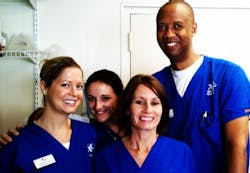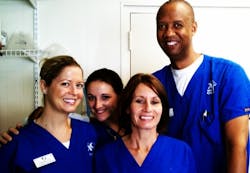Pet volunteer
Hygienist offers skills to animal clinic, which includes petting
by Sue Humphrey, RDH, MA
The May 2011 issue of RDH featured an informative article titled, “So you want to be a volunteer?” Several months ago, I asked myself the same question. The answer was, “Doing what?” First, I looked at what issues I feel passionate about, and animal welfare topped the list. Then I took stock of my marketable skills, which I realized are mainly related to dental hygiene. How was I going to combine two seemingly divergent interests? Then it hit me—I could volunteer at an animal clinic, cleaning the teeth of dogs and cats.
The author, at front right, poses with some of the veterinary technicians at the animal clinic where she volunteers.
Individuals become involved in causes because they feel they can make a difference; their participation is effective.1 They possess a sense of self-efficacy, which is the belief in one’s capabilities to motivate one’s self, use cognitive resources, and take the needed course of action to meet situational demands.2 Calling upon my cognitive resources, I sent an email to Animal Coalition of Tampa.
Tampa, Fla., can boast to being the home to Animal Coalition of Tampa (ACT), a high-quality, high-volume, low-cost spay/neuter clinic dedicated to providing affordable veterinary services in order to “see a day when no pets will go unloved and no more healthy animals will be destroyed because their guardians could not afford to do the right thing.” I contacted the director of the clinic who put me in touch with the medical director. Yes, they would love to have me help out with their “dentals.” I warned them that not being a trained veterinary technician, I am not qualified to administer anesthesia or perform extractions. But that did not matter. Any help I could offer would be appreciated.
The reasons for cleaning dogs’ and cats’ teeth to maintain dental health and the consequences for not doing so are the same as for humans. The bacteria and inflammation associated with periodontal disease contributes to kidney failure, heart disease, and liver problems. Sore gums and loose teeth cause pain and difficulty in chewing and swallowing. Healthy teeth and gums promote comfort and longevity to the lives of companion animals.
The equipment and procedures used to do cleanings on animals are the same as for humans but the tooth morphology is different. I scale using a cavitron and then polish using the same prophy paste used in dental offices. The saying “Form follows function” can be illustrated in the shape of dogs’ and cats’ teeth. Both are carnivores and as such, their teeth are pointed like steep mountains designed to incise with no flat occlusal surface on the molars. The teeth are narrow from buccal to lingual so there is only a small interproximal area; a sulcus of greater than 2mm is considered abnormal in dogs and greater than 1mm is abnormal in cats.
First, the technicians anesthetize the cat or dog, and then I do the cleaning. If I see loose teeth, I tell one of the techs, and they do any necessary extractions. Afterwards, the patient is given an injection of pain medication and an antibiotic. If there has been a lot of bleeding, I swab the gums with chlorhexidine. From there, the animal is moved to the recovery area where they will be monitored until they regain consciousness. All services and medications are recorded on the patient’s record, just like in a dental office.
Besides performing prophies, other aspects of dental hygiene training are useful in the veterinary setting. Aseptic technique is important. I clean examining tables and equipment between patients, scrub surgical instruments prior to placing them in the ultrasonic cleaner and autoclave, and I clean cages. I observe and monitor vital signs while the animals are under anesthesia and in the recovery area as they come out of the anesthesia. One day I was in the recovery area when a cat had a seizure. I was able to recognize it immediately as abnormal and notify one of the techs so they could stabilize the patient.
Dealing with pets’ owners is very similar to dealing with children’s parents. Many people view their beloved pet as a member of the family and are very concerned about their pet’s welfare and condition during and after surgery. It is not unusual for an owner to call to check on how their pet is feeling. They want to be reassured that everything is OK.
Offering TLC to the patients is an important part of veterinary care and a part that comes naturally to an animal lover. Every employee at the clinic, front desk people and clinical personnel alike, stops to pet dogs and stroke kitties. The cat room and dog room are frequent destinations for a quick break.
Each animal is called by name; there is nothing impersonal about the treatment they receive at ACT. Animals are often apprehensive or scared in a veterinary environment, and a reassuring scratch or pat calms them. After surgery, a soft stroke and speaking an animal’s name is enough to stop a dog from whimpering. The nurturing skills used to calm an anxious animal are similar to the nurturing skills used to calm an anxious patient in the dental chair (though I wouldn’t recommend scratching a patient behind the ear!).
Volunteering at ACT has been a rewarding and an educational experience for me. I have bombarded the vet techs and vets with pet health questions and they have patiently answered me. Likewise, they have asked me many dental questions, so another aspect of volunteering has been that of educator and ambassador. Dental hygiene training provides many avenues of expression which can be utilized to make the lives of others, both two-legged and four-legged, better. I would highly recommend to anyone considering volunteering that they not limit their hygiene expertise to just humans. Our furry friends need us too.
Loretta Sue Humphrey, RDH, MA, graduated from Palm Beach Junior College in 1976 and has been in clinical practice ever since. She received her bachelor’s and master’s degrees from the University of South Florida. Sue lives and works in St. Petersburg, Fla., and divides her time between working in a private practice, writing, mentoring prospective dental hygiene students, volunteering, and involvement in animal welfare causes. She is a member of the American Dental Hygiene Association. The author can be reached at [email protected].
References
- Meyer D. (2002) The Politics of Protest. New York: University Oxford Press.
- Bandura A. (1977) Social Learning Theory. Englewood Cliffs, New Jersey: Prentice-Hall.
Pet volunteer
Past RDH Issues

